Introduction
Welcome back for the next part of this saga of sorting through the WHO’s situation reports, Twitter page, and other communications. For this section I continue to follow the Situation Reports from January 22, 2020, tracing the starts of some heavy evidence for the belief that something was rotten in the international halls of this organization. I know it sounds like a vague summary, but trust me, it’s a complete story in its own right.
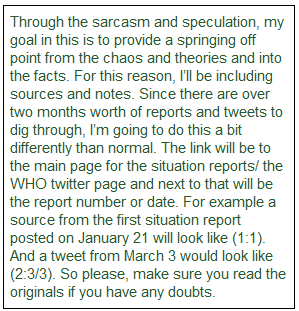
Just a minor head’s up before diving in; the situation reports are very repetitive. I will do my best to use the earliest possible date for when the report began talking about topics, seeing as how the point of this series is to cobble together a loose timeline of sorts, but if I don’t mention everything in a given report each day it’s because the information is mostly repeats of prior content.
A Taiwanese Mystery
I wish things became easier in this section but the questions only manage to get deeper and more tangled as time goes on. Every answer opens another three questions, so forgive me if this starts to wander a bit. To keep myself on some semblance of a track, I’ve picked out what I feel is the biggest, or at least most central, question to help guide the overarching narrative. This will be a bit tricky, seeing as how I lack the authority to draw any definitive conclusions, but I can speculate on the facts at hand and it’s not long before we see hints of potential answers in the texts.

What is the relationship between the WHO and the Chinese government^ in all of this? Specifically, has the WHO taken steps to put China’s image and success over the health and safety of the rest of the world? As favoritism can only be detrimental to the majority of nations who put their trust and funds into the WHO, it’s a serious allegation to lay against them. So grave would discovering a loss of the proper neutrality the organization was built to maintain during such crises be that many governments, in particular the US, have started to probe into the possibility.
To see what we can glean from the reports, let’s look at the cliffhanger from my last post. I gave you a hint that something I had already mentioned in the article might offer a clue as to why the WHO quietly changed their stance on person-to-person transmission in a tweet(2:1/19) the day before the two Guangdong province cases with only a sick family member to act as a source was announced(1:1). If you guessed the Taiwan case of dubious circumstances(1:2), then congratulations, you get internet cookies. (The imaginary ones that date me and my introduction to the internet, not the software ones everyone has to deal with.)
Without breaking focus too much let’s take a second to address the issue with Taiwan itself and how the WHO refers to the country. They mention Taiwan as if it were a part of China, not its own nation(1:2). There has been back and forth on the topic for years now, with many nations not wanting to go against the manufacturing powerhouse that is China and risk upsetting their own personal trade or starting conflict over acknowledging Taiwanese independence(3). Though I personally loathe the decision, I can’t say I hold the WHO solely or even primarily responsible for not breaking the pattern by continuing to refer to Taiwan in the way the US would refer to Ohio or Kentucky.
What I do take issue with is how Taiwan’s first case provides such an overarching example of the way evidence was presented early but not acted upon until far too late. The is not only a dating nightmare for the overall timeline, having her onset as January 11th but not reported until the 22nd, it also throws an ever expanding monkey wrench into the story of transmission as she had no history of contact with any wet markets, no interactions with live animals, no trips to the patients in Wuhan hospitals, or anyone else known to have the virus(1:2). So how did she get sick?
Most likely, not by an animal, a research study, referenced by the WHO in one of their situation reports and conducted in the UK, determined. Aside from the fact that less than 15% of new cases were linked to direct visits to the Hunanan market at the time; which would greatly limit the possibility of animal exposure(1:3) (because apparently closing down the offending wet market on the first of the month(1:1) didn’t do the trick), there was very little variation in the genetic makeup of the virus, suggesting that it was both very young and had made a single leap from humans to animals. It looks like all transmission of the virus may have occurred by some form of person-to-person means other than that first infection. (1:3) Oops.
With that statement on paper it’s hard to see why they paid such attention to the close nature of the relationships of the two Guangdong cases, giving a false impression such ties are necessary to spread the illness. (1:3) After all, if it was only family and friend ties that could spread the virus, I doubt confirmed cases would have jumped by 11% in one day up to 314* with sixteen healthcare workers coming down with the illness(1:2). This sudden spike in medical personnel cases is a bit disconcerting, two fifths of new cases and 5% of the total count, especially since the WHO considered 2019-nCoV to be not very active within hospitals when compared to MERS or SARS in the next report(1:3).

Theoretically this is one of the assessments the WHO should have been primed to change at any moment, especially seeing as how their favorite mantra is the Platonian mantra that all we really know for sure is how little we know about the virus. Not to worry though; figuring out the source, transmission, and best containment method was decided on as the focus for the emergency committee that met on January 23(2:1/23). The committee had originally been called together to determine if the novel coronavirus could yet be classified as a Public Health Emergency of International Concern(2:1/21). They concluded that it was too early to call it much more than an alert for the global community and that China was still the primary focus of the disease(2:1/23).
The idea of containment and mitigation seemed to strike a chord with other nations that stepped up their own protocols for keeping new cases out and striving to get ahead of the spread from any infections already present in their countries. The US CDC, for example, continued with what seemed to be working and expanded their entry screening stations to include Atlanta and Chicago airports and took their own tests to Washington state to track down anyone who might have been exposed to the initial case. (1:3)
Seemingly in response, the WHO maintained that entry screenings were practically useless in their newest travel advisory report posted on January 24th. This advice was given on the same page where they indicated that a majority of cases known about outside of China were picked up via such methods. I wish I was making that up. So yeah, despite the fact that patients may throw off thermometers by taking a few aspirin on the way over, checking upon entry might still do some good. (4) With the fever intervention as their main case for why entry screenings are an expensive waste of time, while in the same breath and in later reports praising exit screenings as useful, I find myself asking: does China not let people take medicine for fevers until they get on an airplane?
You may be wondering why travel with China was still going on once person-to-person transmission had been confirmed and even our mystery girl from Taiwan was known about. Well, as far as the WHO was concerned, it was still safe– and important–to continue traveling to China for the holiday season that they helpfully recorded would cause an explosion in cases the day before it happened(4). But don’t worry, Wuhan won’t be holding any big events(4) which is the closest the WHO gets to admitting that China itself cut its losses and closed the entire city down on the 23rd(5). I don’t know about you but I don’t think I’ve ever heard a more blatant yet underhanded way of saying that traveling to an area is a one way ticket to infection.
With only 587 cases and 17 deaths reported on the 23rd, China’s movement to shut down appears to be a quick and prudent call. Then you look at the second report from the UK that was referenced by the WHO and the doubts resurface. Using what they had seen, what they believed due to their assessment of its transmissibility, and an average period of ten days between infection and discovery of a case; the report estimated that as of January 18 there should have been anywhere from one thousand to nine thousand cases in China, with four thousand being the average. (1:3)
After the debacle of ‘two hundred thousand to two million deaths’ that took place here in America, I’ve learned to take these mathematical guesstimations with a grain of salt. Still, on the low end China could have had twice what they were reporting while on the high end it’s nearly twenty times the amount. Their quarantine shutdown sounds a bit less preventative and a bit more desperation at that point. But, assuming the math isn’t completely wrong, where are the other cases? Does it have anything to do with the Taiwan mystery?
The WHO and their team began asking new questions too, once there was too much evidence to deny that person-to-person transmission was possible and likely the primary means of spreading the virus. Recalling MERS and SARS again, they began to talk about the role droplets and fomites–aka contaminated surfaces–might play in the process. They redoubled their calls for cleanliness to limit further exportation and even sent masks to the people of Macau in an effort to slow the spread. (1:4) {Don’t get used to that!} However, they just as loudly disavowed any avoidance of travel or
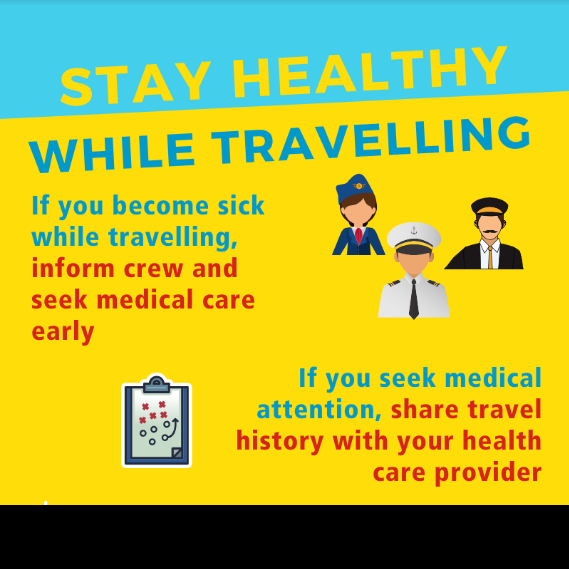
trade with China. As long as you kept your germs to yourself, washed after touching anything, and immediately ran to the doctor upon getting sick to tell them you went to China during the outbreak because the WHO said you would be mean if you didn’t, they were confident the virus would be reigned in. The only other advice given for travelers was that anyone who came into contact with someone who had the illness needed to remain in isolated observation for fourteen days to wait out the incubation period. (4) Did I mention it’s definitely safe to go to China?
Really, it’s fine you guys. This is definitely not the point where I started having a hard time convincing myself to give the WHO the benefit of the doubt. Not at all. They certainly don’t seem like they’re encouraging dangerous travel by constantly reiterating that there was only one known case of person-to-person transmission to happen outside of China(1:5), as if a border might turn off that trait. And it totally doesn’t seem disingenuous to say that after the UK report suggesting that all the transmissions were person to person(1:3), which would make sense because it’s been OVER THREE WEEKS since the market that started it all was closed and there are still new cases coming forward(1:1). And I’m not at all suggesting it’s outright sinister to claim that the main goal at this point in the fight was to prevent further exports of the virus to other nations while also repeating on the daily that there should be no interruptions to international travel or trade(1:5), especially when some quick math of the numbers provided by China reveals a 3% death rate up to that point.
No, I’m not suggesting it. But it sure as hell has done a pretty good job of suggesting itself. Nothing seems to add up when it comes to the tweets and the reports. Two days after suggesting a fourteen day quarantine for anyone exposed to a visibly sick person(4), the WHO tweeted both that they estimated the incubation period to be two to ten days and that MERS was known to have asymptomatic carriers(2:1/26). And there we have our first potential answer, and my personal belief, on how the Taiwan case came about.
Up to this point, the emphasis has been strictly on patients with symptoms. The fever screenings, the respiratory signs, and the suggestions of isolation all center on patients who show symptoms of their illness. An asymptomatic and undiagnosed patient would leave a more susceptible person ill with no apparent reason why. It’s not the only possible answer, but once more it will be a distressingly long time before either one is brought up again. (That’s right, I already mentioned the other method. : P Can you guess before I bring attention to it?)
After mentioning that they don’t know what role asymptomatic carriers and patients within the incubation period play in the spread of the virus(1:7) and that scientific journals had agreed to forego their normal wait period and paywall on all articles involving the virus (2:1/26) the WHO announced that it was sending some of their highest members to China to speak directly with President Xi and those working on the front lines(1:8).
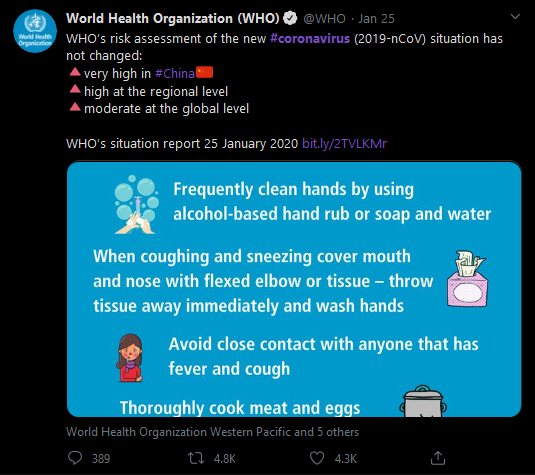
Almost as if they were getting a new perspective on something, their attitudes began to change in a more serious and desperate direction after this meeting. At least as much as they could without coming out and nullifying everything that had been said up to that point. Economic problems and suggestions for mitigating them began to appear. An anonymized submission form database for nations to share data from any and all cases they discovered was finalized. (1:8) The Emergency Committee was called back after less than a week to see if they had maybe changed their mind about the PHEIC status of the virus (2:1/29). They even broke down and admitted entrance screenings could be of some use if utilized alongside other methods, though they should be limited to planes arriving from known hotspots for practicality (2:1/29).
Over night, while there were only 68 cases of the virus outside of China(1:9), and while the virus was still seen as a China problem and not a global one(2:1/29), the WHO had formed another committee, this time called the Pandemic Supply Chain Network(1:9). The purpose of the PANDEMIC supply chain network was to assess and plan for global PPE demand. I don’t know what I find weirder, them suddenly seeming to know that there is going to be a wild demand for PPE while there are only 6065* cases with 1239* hospitalizations and 132* deaths, the fact that they use the word pandemic before they have even admitted it’s an international health emergency, or the fact that they emphasize focusing on symptomatic travelers three days after bringing up asymptomatic carriers as possible contributors(1:9).
So the emergency committee sat down for their second meeting on January 30(1:10) to debate whether calling the situation a public health emergency of international concern was worth the fear that term would stir up(2:1/30). Yes, because I know my first thought while scrambling to secure PPE and prepare for something big that I’ve been ignoring for a month until seeing the first hand devastation is to consider whether Susan might get the vapors over learning this disease is something that could directly impact her life. During that very important meeting, that apparently took more talking than the five minute phone call it should have been, the WHO used the special focus section in their situation report to explain why they were still calling the novel coronavirus 2019-nCoV and not a proper name. The answer was that apparently the World Organization for Animal Health (OIE) {no, I don’t know where that acronym comes from} and the Food and Agricultural Organization (FAO) needed to be part of the overall naming decision and that it couldn’t be finalized until the new book detailing diseases was officially published. (1:10) Because books can’t be edited or something.
To no one’s surprise, or at least no one would have been very surprised if they had been following along this closely at the time, the committee announced that this virus was, in fact, a PHEIC by January 31, 2020. They also handed down a tiny recommendation for the WHO to find a way to create a third step in the grading scale between PHEIC and no PHEIC without having to rewrite their entire rulebook. (1:11) Sounds like maybe this wasn’t being taken as seriously as it should have been after they decided it wasn’t that big of a deal last week.
With the decision finally being made, how did the WHO change their approach? Education seemed to become one of their focal points with the release of the EPI-WIN program to share targeted information with at-risk communities and the launch of a mythbuster campaign to combat false information about the virus. (1:11) I’m not sure if this is when the campaign was started, it may have been shown in the tweets before now, but as this is its first mention in the situation report I’m going to take a minute to cover the information here as accessed on 4/23/2020, so there might be a few newer ones that weren’t on the list in January/February.
When asked about treatment; they mention that there is no medicine to prevent or treat the coronavirus, specifically pointing out that antibiotics are for bacterial infections not viral ones(6).
When asked about who is at risk; they mention that anyone can become infected, though the elderly and those with pre-existing conditions are more susceptible(6).
When asked about at-home ways to prevent illness; they say that no matter what the alternative medicine guru on Facebook says, eating an entire garlic bulb and flushing with saline won’t keep you from getting it. And please for the love of all that is holy don’t douse yourself in alcohol or chlorine that will kill you(6).
They clear up confusion about the stages of the disease by mentioning that despite pneumonia being one of the worst outcomes of the virus, the vaccines currently available to protect against pneumonia won’t work(6).
When asked about UV lamps for sanitation they state those will just cause skin irritation, though the graphic doesn’t confirm or deny that the virus will die(6).
A series of their graphics deny any temperatures will help with defeating the coronavirus be it hot baths, cold weather, heat, or humidity(6).
When talking about transmission, they point out this is one thing mosquitoes can’t be blamed for(6).
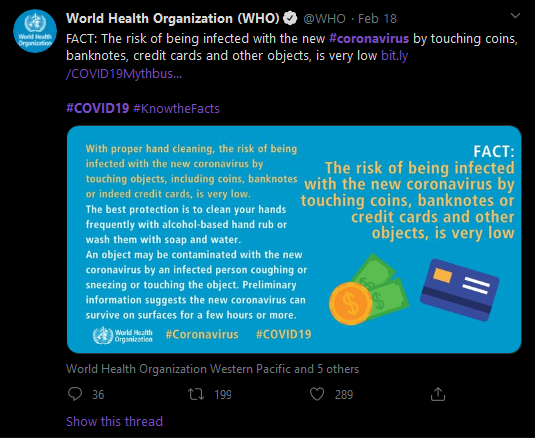
There are others to be found but more importantly, there are some missing from the last time I went to the page about a week ago. Perhaps when they added that 5G isn’t the cause(6), they also pulled these ones, which were the ones I specifically was wanting to talk about. Luckily, there is no edit button on twitter and I got screenshots, though I don’t think they are very good at remembering to take down incriminating tweets so you might be able to find them.
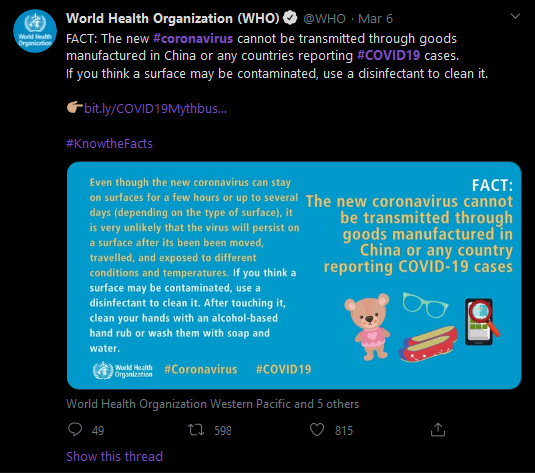
On February 18 (again I don’t know when this was first added to their mythbusters) they posted as fact that “the risk of being infected… by touching coins, banknotes, credit cards and other objects, is very low.”(2:2/18) The other one that I wanted to bring up that I screen-capped from March 6 said “the new coronavirus cannot be transmitted through goods manufactured in China or by any countries reporting COVID19 cases. If you think a surface may be contaminated, use a disinfectant to clean it.”(2:3/6) I’ll definitely be adding those tweets to this post so I can show that I’m not crazy. I’m so glad that I capped them. It feels like I caught them with their pants down.
Why? Well, if you hadn’t guessed, this claim paired with how the WHO had become so demanding that trade and travel with China remain open at this point–even going as far as to say that restricting either (even as they warned countries to prepare for an onslaught of the virus in the same severity as what Wuhan had faced) was creating stigma and that nations who had shut their borders had 48 hours to provide scientific evidence to the WHO to back up their decision for them to decide whether they felt it was justified and that they felt it their right to advise nations to change their minds if they didn’t agree(1:11)–is my second guess for how the mystery Taiwanese girl got her seemingly unconnected infection. I know that sentence is a nightmare so let me break it down.
According to the US CDC, the coronavirus can live on surfaces for hours to days. Their article on sterilizing contaminated areas suggests that you can’t be sure an unsanitized surface is free of pathogens until a full seven days have passed. (7) Seven days seems like plenty of time to make it from the factory to the customer, especially in the era of express shipping. It also makes you want to avoid paying in cash and to wipe down your debit card after every use.
I feel safe saying the WHO already held their belief in the safety of money and goods in late January, even if the tweets are from later. If not for the constant calls for continued trade with China, then for the fact they dismissed asymptomatic patients as a significant carrier since they wouldn’t be coughing and sneezing their germs on everything(1:12). I guess the WHO members have never heard of a kiss, which now that I think about it might be half the reason why Europe took a gut punch on this one.
Speaking of Europe, things were starting to heat up there with France reporting the first European doctor succumbing and evidence that even non-Chinese sufferers could pass on the illness to others(1:12). Yeah, I don’t know why they felt the need to say that either. Maybe they were just so convinced everyone else is being racist about things that they made a racist statement that no one with half a brain cell would have otherwise entertained. Except maybe for the people who read the first 11 reports where the WHO seemed to have a vested interest in saying that all cases outside of China were travelers from China which made it less of a big deal or something. (1:1-11) And they want to know why people started calling it the Wuhan virus or, more epicly, Kung Flu.
If you’re keeping count, Situation Report 12 came out on February 1, 2020 and my eagle eyed American readers are likely on the edge of their seat waiting for me to go back and tackle the second half of my jumbled up run-on sentence. The half about the passive aggressive declaration when the WHO had dropped all pretenses of asking people to keep trading with China by threatening that nations MUST comply by submitting a report as to why they might close their borders(1:11). I thought this was in response to America on my first read through, both from unfortunate geographical bias and the late realization that the article was using information from the day prior so anything that happened on the day of the report couldn’t have been referenced. However, the US limited travel from China for all foreign nationals who had come from Wuhan or laid over there on the same day as the report so technically, it wasn’t directed at them. Yet. (8) This means the WHO was actually yelling at Russia, North Korea, and Mongolia who had all shut down their borders by the 30th(9). I wonder if their leaders had to put up with the opposition loudly declaring them racists. OH! Wait… Right. Russia and North Korea.
Scoldings aside, the first death outside of China took place in the Philippines and UNICEF and IFRC joined the WHO to plan outreach to poor and at risk communities to increase education(1:13). Their website also launched the virus dashboard to let the public easily track cases reported, their Pandemic network began to shift around their available commodities, and outbreak kits to assist countries with management were thrown together(1:14). Hard to believe the most cases in a single country outside of China is only 20 at this point.
After the EPI-WIN program contacted manufacturers directly about the PPE concerns they had(1:15), the WHO brought up part of their response plan which acknowledged at last that the tourism industry might suffer a bit if they didn’t start planning for how to make it safer(1:16). That should have maybe crossed their minds back on January 13 when the first exported case was reported, but they still don’t recommend closing down travel or anything so I can’t say them worrying about it sooner would have been much help. They don’t even have a plan for decontaminating or even letting products from hot zones air out because I guess having to admit person-to-person transmission was enough going back on their assertions for one month. (1:16)
Just… Is there any wonder we got into this mess? Getting them to admit they made a mistake is harder than pulling a loose tooth from the mouth of a hyper anxious child. But if you want the WHO to take an actual preemptive measure by advising nations to do something simple that may help before there is ‘strong evidence’, then you might as well be slicing their tendons out of their ankles because they’re not going to budge until an independent scientist takes a piece of data from weeks prior and explains to them it means they should have been advising people to take helpful steps before it became too late to help.
I’m going to cut part two here. Originally, I wanted to make it all the way to when they accepted we had a pandemic on our hands but that’s still a month away and I think the saga of the Taiwanese mystery case and the two big possibilities to explain it that the WHO ignored makes its own effective chapter. It’s not even that they ignored it really, they talked about both but kept pretending like it wasn’t a big deal all through the period of time it might have been useful advice to pay attention to. I wonder if someone is being held hostage and trying to get out the real information without pissing off the higher ups. On a less conspiratorial note, they need a better editor because they’re up to about six erratum corrections at this point; some with more attention brought to them than others.
Sources
- https://www.who.int/emergencies/diseases/novel-coronavirus-2019/situation-reports
- https://twitter.com/WHO
- https://www.thoughtco.com/is-taiwan-a-country-1435437
- https://www.who.int/news-room/articles-detail/updated-who-advice-for-international-traffic-in-relation-to-the-outbreak-of-the-novel-coronavirus-2019-ncov-24-jan/
- https://www.nytimes.com/article/coronavirus-timeline.html
- https://www.who.int/emergencies/diseases/novel-coronavirus-2019/advice-for-public/myth-busters
- https://www.cdc.gov/coronavirus/2019-ncov/community/organizations/cleaning-disinfection.html
- https://www.statnews.com/2020/01/31/u-s-declares-public-health-emergency-over-coronavirus-bans-travel-from-china-by-foreign-nationals/
- https://apnews.com/4ab3d1f101c55f376e204727e620afc4
^ I shouldn’t have to say this, but I will. When I’m talking about China in these reports, I’m talking about the Chinese government. Specifically the Chinese Communist Party lead by President Xi which is currently in power. The average citizen of China is as much a victim of the current regime as the rest of the world and I’m not trying to pick on them doing what they need to in order to survive.
* All counts are taken from the WHO reports as they were presented to them by China. We all know the counts are a lie, but for this series focused on primarily the information the WHO made available, I will still be using what is provided.
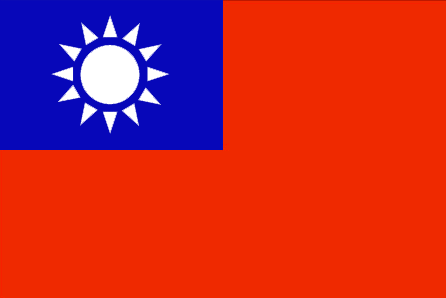

One thought on “WHO Knew What When? Part Two: Red Love Affair”